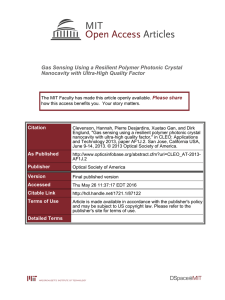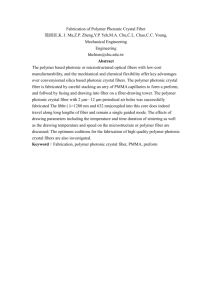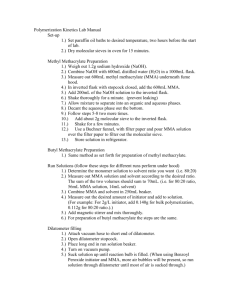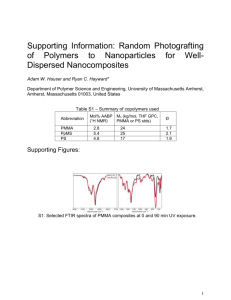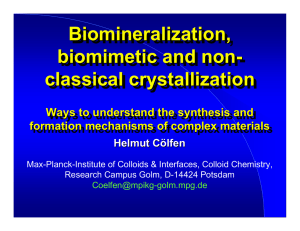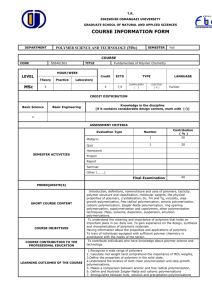Epitaxial Single Crystal Surface Patterning and Study of Physical
advertisement
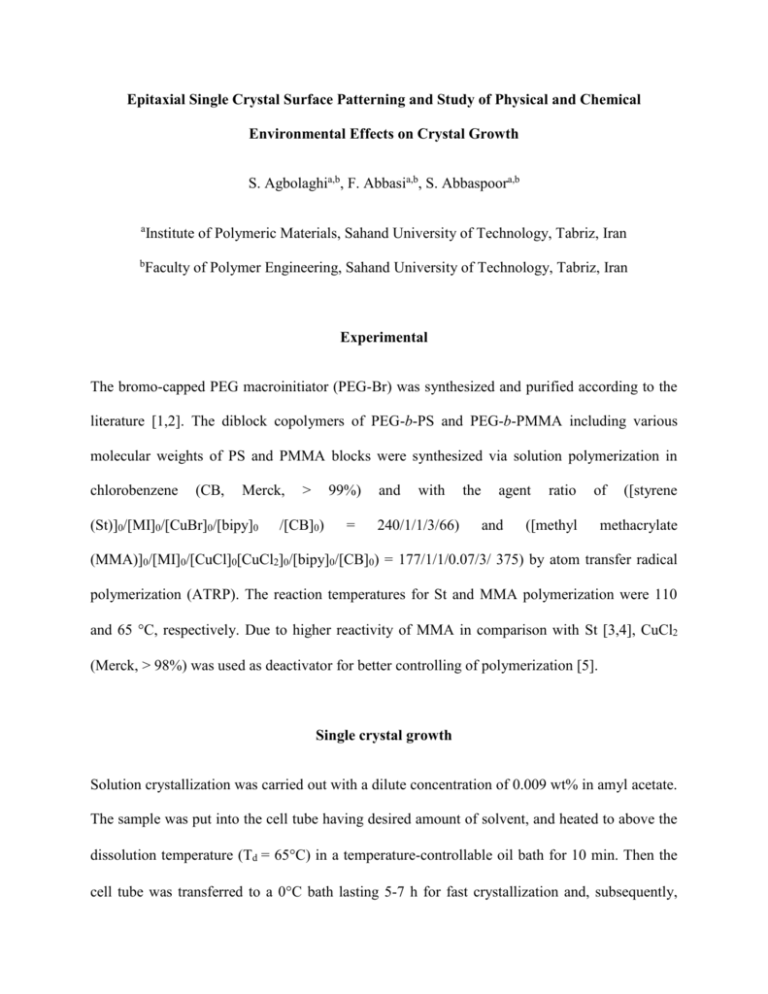
Epitaxial Single Crystal Surface Patterning and Study of Physical and Chemical Environmental Effects on Crystal Growth S. Agbolaghia,b, F. Abbasia,b, S. Abbaspoora,b a b Institute of Polymeric Materials, Sahand University of Technology, Tabriz, Iran Faculty of Polymer Engineering, Sahand University of Technology, Tabriz, Iran Experimental The bromo-capped PEG macroinitiator (PEG-Br) was synthesized and purified according to the literature [1,2]. The diblock copolymers of PEG-b-PS and PEG-b-PMMA including various molecular weights of PS and PMMA blocks were synthesized via solution polymerization in chlorobenzene (CB, Merck, (St)]0/[MI]0/[CuBr]0/[bipy]0 > 99%) /[CB]0) = and with 240/1/1/3/66) the agent and ratio of ([methyl ([styrene methacrylate (MMA)]0/[MI]0/[CuCl]0[CuCl2]0/[bipy]0/[CB]0) = 177/1/1/0.07/3/ 375) by atom transfer radical polymerization (ATRP). The reaction temperatures for St and MMA polymerization were 110 and 65 C, respectively. Due to higher reactivity of MMA in comparison with St [3,4], CuCl2 (Merck, > 98%) was used as deactivator for better controlling of polymerization [5]. Single crystal growth Solution crystallization was carried out with a dilute concentration of 0.009 wt% in amyl acetate. The sample was put into the cell tube having desired amount of solvent, and heated to above the dissolution temperature (Td = 65C) in a temperature-controllable oil bath for 10 min. Then the cell tube was transferred to a 0C bath lasting 5-7 h for fast crystallization and, subsequently, immersed into given self-seeding oil bath, and kept for 20 min. The cell tube was then quickly transferred into a desired isothermal oil bath adjusted at crystallization temperature, and maintained for 2 days. Apparatus The chemical structure of block copolymers was confirmed by 1H NMR spectroscopy on a Bruker (Avance DPX) spectrometer working at 400 MHz, which was also used to determine the composition of the copolymers. Deuterated chloroform (CDCl3) was applied as a solvent. The polydispersity indexes were determined by GPC on a Water1515 gel permeation chromatography instrument with a set of HT3, HT4, and HT5, μ-styragel columns with DMF and THF as eluents (1.0 mL/min) for PS and PMMA, respectively, at 35C. A set of monodisperse polystyrene standards were utilized for calibration. To measure the totalthickness of single crystal and identify the surface morphologies by surface stiffness changes and height variances, the single crystal dispersion was dropped onto a silicon wafer and quickly dried by a stream of high purity nitrogen and observed under an atomic force microscope (AFM, Nanoscope IIIA). A silicon tip in the tapping mode was utilized. During AFM scanning, the cantilever tip-to-sample force required to be carefully adjusted to avoid damages. For the tip-to-sample force, a large force could lead to tip penetrations into the thin tethered chain layers, and disturb the materials at the layer surfaces. A scan rate of 1 Hz and a resolution of 512×512 were selected to take high quality images. Single crystal structure and morphology was observed in a transmission electron microscope (TEM, EM 208 Philips) with an accelerating voltage of 100 KeV. The selected area electron diffraction (SAED) experiments were also conducted to determine the chain orientation in the copolymer single crystals. Tables Table S1. The effect of PS block molecular weight on various parameters of mixed-brush single crystal 11.4 4.0 3.7 0.58 0.30 350 18.2 5.5 6.4 11.5 4.0 3.7 0.41 0.30 342 20.1 4.4 7.8 11.4 4.0 3.7 0.33 0.30 337 (nm) 4.2 Domain size 7.7 PMMA (nm-2) dtotaldispersed(nm) 16.1 PS (nm-2) dPSmatrix(nm) dPMMAdispersed(nm) dPEGmatrix(nm) PEG5000-b-PS4600 dtotalmatrix(nm) Sample dPEGdispersed(nm) channels /PEG5000-b-PMMA8700 PEG5000-b-PS10000 /PEG5000-b-PMMA8700 PEG5000-b-PS14800 /PEG5000-b-PMMA8700 Table S2. The effect of PMMA block molecular weight on various parameters of mixed-brush single Domain size(nm) PMMA(nm-2) PS(nm-2) dPMMAdispersed(nm) dPEGdispersed(nm) dtotaldispersed(nm) dPSmatrix(nm) dPEGmatrix(nm) Sample dtotalmatrix(nm) crystal channels PEG5000-b-PS10000 18.2 5.5 6.4 11.5 4.0 3.7 0.41 0.30 342 18.2 5.5 6.4 12.5 3.4 4.5 0.41 0.25 317 20.1 4.4 7.8 11.4 4.0 3.7 0.33 0.30 337 20.1 4.4 7.8 13.4 2.9 5.2 0.33 0.22 288 /PEG5000-b-PMMA8700 PEG5000-b-PS10000 /PEG5000-b-PMMA13100 PEG5000-b-PS14800 /PEG5000-b-PMMA8700 PEG5000-b-PS14800 /PEG5000-b-PMMA17100 References 1. Jankova, K.; Chen, X. Y.; Kops, J.; Batsberg, W. Macromolecules 1998, 31, 538. 2. Xiao, Q.; Zhang, X.; Yi, J.; Wangand, X.; Zhang, H. Iranian Polymer Journal 2008, 17, 781. 3. Matyjaszewski, K.; Davis, T. P. Handbook of Radical Polymerization, Australia, By John Wiley and Sons, Inc., Hoboken, 2002. 4. Reining, B.; Keul, H.; Hocker, H. Polymer 1999, 40, 3555. 5. Siegwart, D. J.; Wu, W.; Mandalaywala, M.; Tamir, M.; Sarbu, T.; Silverstein, M. S.; Kowalewski, T.; Hollinger, J. O.; Matyjaszewski, K. Polymer 2007, 48, 7279.





